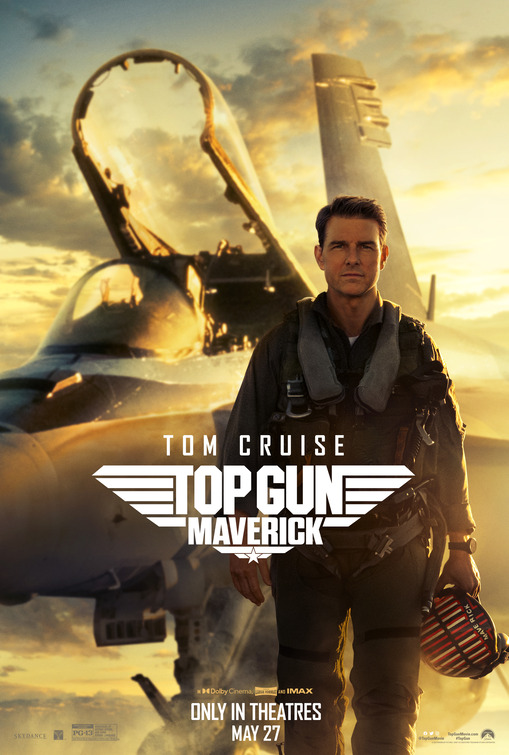Top Gun Maverick Soars With Drama and Action
What a ride.
The much Pandemic-delayed movie Top Gun: Maverick launched into movie theaters recently and is set to make records. The commercial box office success is well earned. It’s a better movie than the original Top Gun, in drama as well as action.
Maverick may also well restore (a smidgen of) confidence in Hollywood’s ability to tell an unabashed story of patriotism and commitment for modern audiences.
 Plot Fits Modern-Day Geopolitics
Plot Fits Modern-Day Geopolitics
Maverick‘s core plot hinges on the need to take out a military grade nuclear facility created by a rogue nation. The theme fits well into today’s geopolitics as America and its allies struggle with containing hostile nations such as Iran and North Korea, who aspire to create effective nuclear arsenals. In Maverick, the US Navy has been tasked with sending in an elite team to take out the facility in a highly targeted, high risk raid. The likelihood any of the pilots will come back alive is slim.
The movie’s screenwriters have crafted an intriguing scenario within which the mission’s success depends critically on the use of older fighter pilot technology—F/A-18s rather than more modern stealth fighters or other “Fifth Generation” fighters. The target’s air defense presumes a sophisticated attack with the latest technology. F/A-18 capabilities, while heightening risks to the pilots and mission success, allow skilled aviators to avoid the modern air defenses surrounding the facility and reach the target.
Subtle Plot Point Central to Maverick’s Success
The chief advantage of the older technology is that the F/A-18’s speed and maneuverability increase its likelihood of reaching its target. The chief disadvantage is the team is less likely to survive the retaliation after their inevitable discovery. This dichotomy between technology and mission success gives the mental state of the fighter pilots—and their trainer—a central role in the film’s conflict. The conflict is never fully resolved until the final minutes of the movie.
Complicating the mission is Captain Pete “Maverick” Mitchell’s (Tom Cruise) age. Or, more accurately, maturity. As he approaches what may be his last assignment as an active duty aviator, Maverick is grappling with his own professional and personal failures—his womanizing past, his commitment to being a fighter pilot, and, the personal legacy of the loss of his best friend (Goose) to a training accident during his first stint at Top Gun.
Drama Drives the Maverick‘s Story
Numerous storylines allow the human drama to drive the movie. Action scenes are layered in at critical moments to keep the movie’s pace aggressive. The most important plot for the mission’s success is Maverick’s relationship with Goose’s son, nicknamed Rooster (Miles Teller, Whiplash, War Dogs, The Divergent Series), now a top fighter pilot. The two have a tense history rooted in Maverick’s awkward attempt to step in as a de facto guardian after Goose’s death.
The more interesting plot line is Maverick’s relationship with Penny (Jennifer Connely, Once Upon A Time in America, A Beautiful Mind, Alita: Battle Angel). A former flame and single mother, she now runs the bar serving Top Gun officers and trainees. Maverick’s burned too many bridges. He has matured enough to want something more than a romantic flash. But his reputation and past limit his ability to connect with Penny and her daughter. The wisdom of age brings a deeper search for meaning and place into Maverick’s life and… it’s complicated.
Balance Between Drama, Action Lifts Maverick
Extraordinary action sequences put Maverick into overdrive at numerous places. But the fighter planes and challenges they pose to the aviators never overwhelm the human drama. The screenwriters, director, and producers have struck a unique balance that elevates Maverick to one of the best films of the year.
Maverick is not without its weaknesses. At times, the movie’s plot seems more Mission Impossible, pushing the edge of possibility, than real-world drama. Maverick’s story arc at times struggles with plausibility. Maverick’s commissioned time as an active duty pilot has significantly exceeded the “retention rank” for officers skipped over for promotion. A Navy Captain (equivalent to full colonel in the Army or Air Force) would normally be “separated” from the service after 30 years. The movie relies on an exception that seems more plot device than plausible.
These concerns are barely noticeable distractions, however.
As a film, Maverick reflects the movie industry’s best attention to craft and detail. The inevitable nostalgic nods to the original Top Gun are seamlessly woven into the updated story. The film is anchored by an exceptionally strong supporting cast. Val Kilmer reprises his role as “Iceman,” now an admiral. John Hamm (Baby Driver, Beirut, Richard Jewell) is the cynical admiral overseeing the top-gun mission, and Charles Parnell as the supportive, but lower ranked admiral in Maverick’s corner.
The supporting fighter pilots are also well cast. Each fits neatly into their respective roles and creates the essential tension among Type A personalities to challenge Maverick as an instructor and team leader. Tom Cruise’s off screen commitment to providing flight “training” to the actors pays off in a big way. Audiences are seeing the actors in real F-18 fighter cockpits. The reactions seem real.
Maverick is a Better Film Than the Original
Maverick is also more than a sequel to the original Top Gun, released in 1986. It’s a better film, with more human drama and well executed action sequences that complement the story. While the audience will likely guess the end in their head, the uncertainties and human conflicts are never resolved easily enough for viewers to be sure. It’s a film well suited for the big screen and IMAX.
The choice to delay the film’s release until the world is emerging from the Pandemic was a sound business decision as well as one that maximizes the audience’s ability to fully appreciate its artistic merits.


















